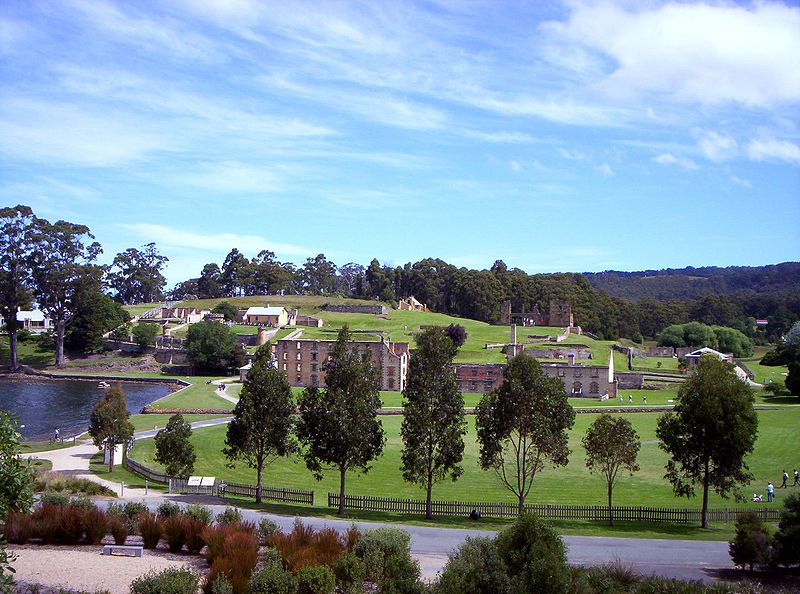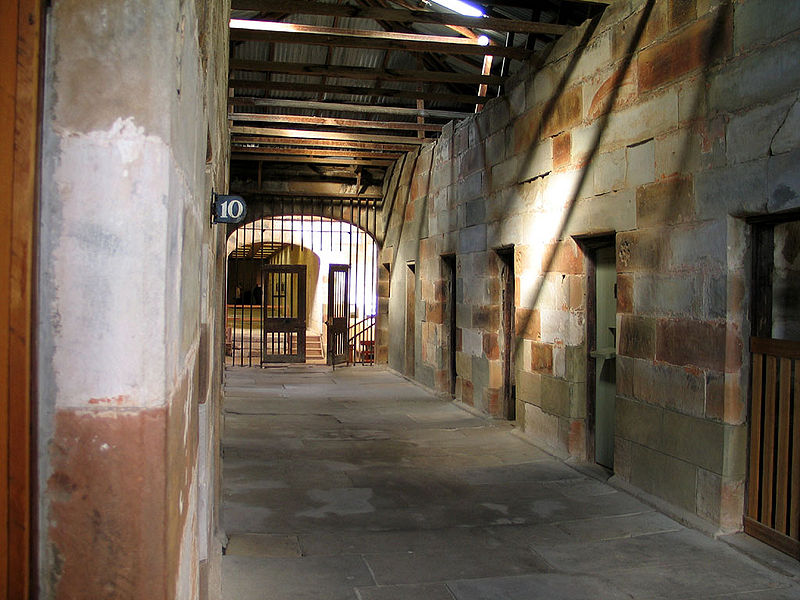Australia For Visitors > Port Arthur, TAS
Port Arthur
Tasmania
Share this page:
Port Arthur, located 60 km south east of Hobart, these days is quiet and peaceful; but in the period from 1830 to 1877 it was the site of a greatly feared penal settlement for the hardened British and Irish convicts who had offended again in the British colonies in Australia (New South Wales and Van Diemen's Land [Tasmania]).
By the time the transportation of convicts to Australia ceased, 12,500 convicts had been sent to Port Arthur. Port Arthur grew to be the British Empire's largest prison.

Port Arthur, Tasmania
The location of Port Arthur was chosen as a "natural penitentiary": a peninsula which was linked back to the mainland just by a tiny isthmus (called Eaglehawk Neck) -- just 100 metres wide. Savage dogs were chained in a row across that narrow strip of land, thus blocking the easiest escape route for absconding convicts. A rumor was spread that the surrounding waters were shark infested. Thus Port Arthur was regarded as a place from which escape was impossible.
The penal settlement was established by Van Diemen's Land's governor, George Arthur. He designed it as a place for convicts whose behavior was regarded by the authorities as intractable and his aim was that a convict's "whole fate should be ... the very last degree of misery consistent with humanity". The worst of the convicts were secured by heavy chains and set to work on excavating stones. If they offended yet again, they would be flogged.
Over the years Port Arthur evolved into a self-supporting industrial center with all manner of trades taught to the convicts and practiced, including brick making, timber milling, ship building, coal mining, wheat growing and milling, nail production and shoe making.
In 1848 flogging was abolished and a new form of punishment -- psychological punishment--- was introduced, which many convicts came to fear even more than the physical punishment of old. In the new system, a new prison, called the Model Prison (also known as the Separate Prison), was built, inside which the convicts were kept in solitary confinement, inside tiny cells, for 23 hours a day.

Inside the Model Prison, Port Arthur
For the remaining hour a day the convicts were allowed to exercise but only inside a walled exercise yard. Absolute silence was enforced and convicts had to war masks or hoods every time they left their cells. Moreover, prisoners were stripped of their identity: they were never addressed by name but just by their prison number. Quite a few convicts developed mental problems; some even went insane and ended up in the mental asylum that had been built next to the Model Prison.
Marcus Clarke's 1870 novel, For the Term of his Natural Life, brought the sufferings of Port Arthur's problems to a wider public.
Port Arthur's prison was closed in 1877. the surrounding town was largely destroyed by bushfires in the 1890s. Only about 60 of the original 260 buildings still remain; but a major restoration effort was undertaken in the 1970s and the area reopened as the Port Arthur Historical Site. The Site is now Tasmania's most popular tourist destination.
Buildings which can be visited included the refurnished and restored prison chapel and the ruins of the Penitentiary, the Model Prison (Separate Prison) buildings, the Lunatic Asylum, the Guard Tower, and the church -- all situated on clipped lawns amid trees and overlooking the cove.
You can also take a cruise out to the Isle of the Dead, with its cemetery where convicts and free settlers were buried, and to Point Puer, the British Empire's earliest boys' reformatory.
In the evenings, you can go on a tour with Historic Ghost Tours to wander Port Arthur's ruins by lantern light and hear tales of the past and stories of ghosts said to wander the ruins) or you can watch a movie version of Clarke's For the Term of his Natural Life.
Share this page:
Author: David Paul Wagner
(David Paul Wagner on Google+)
|